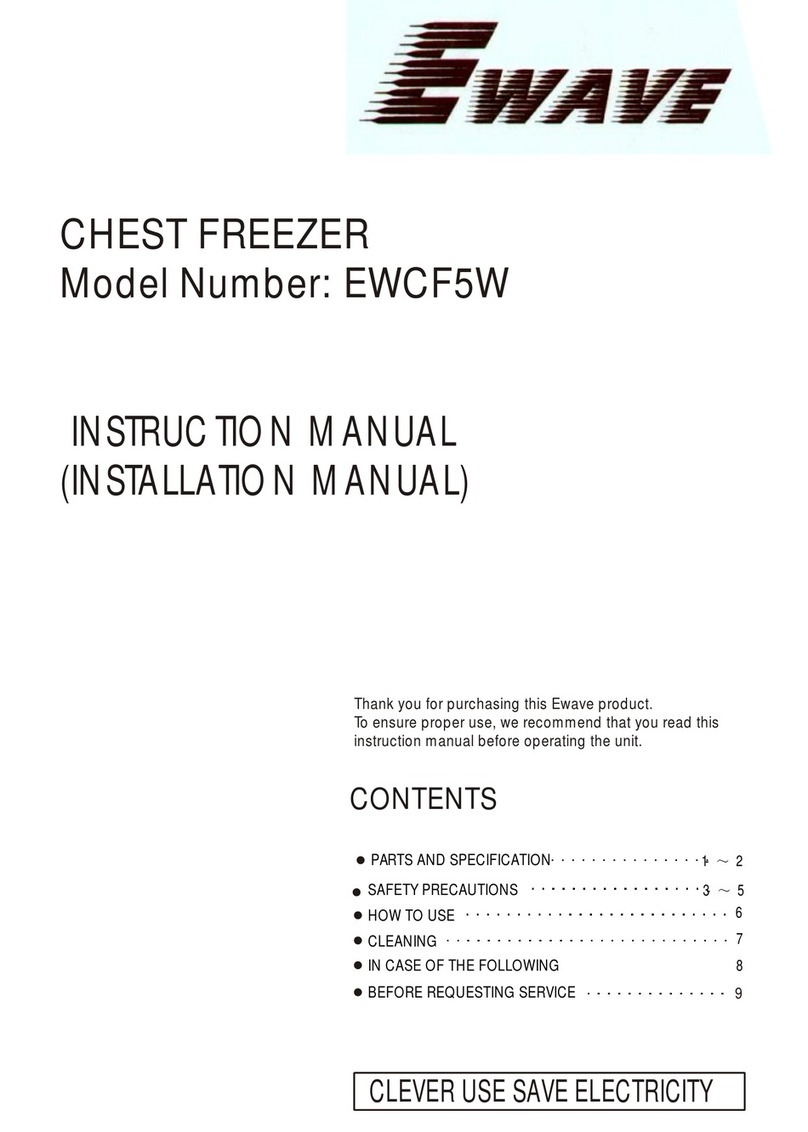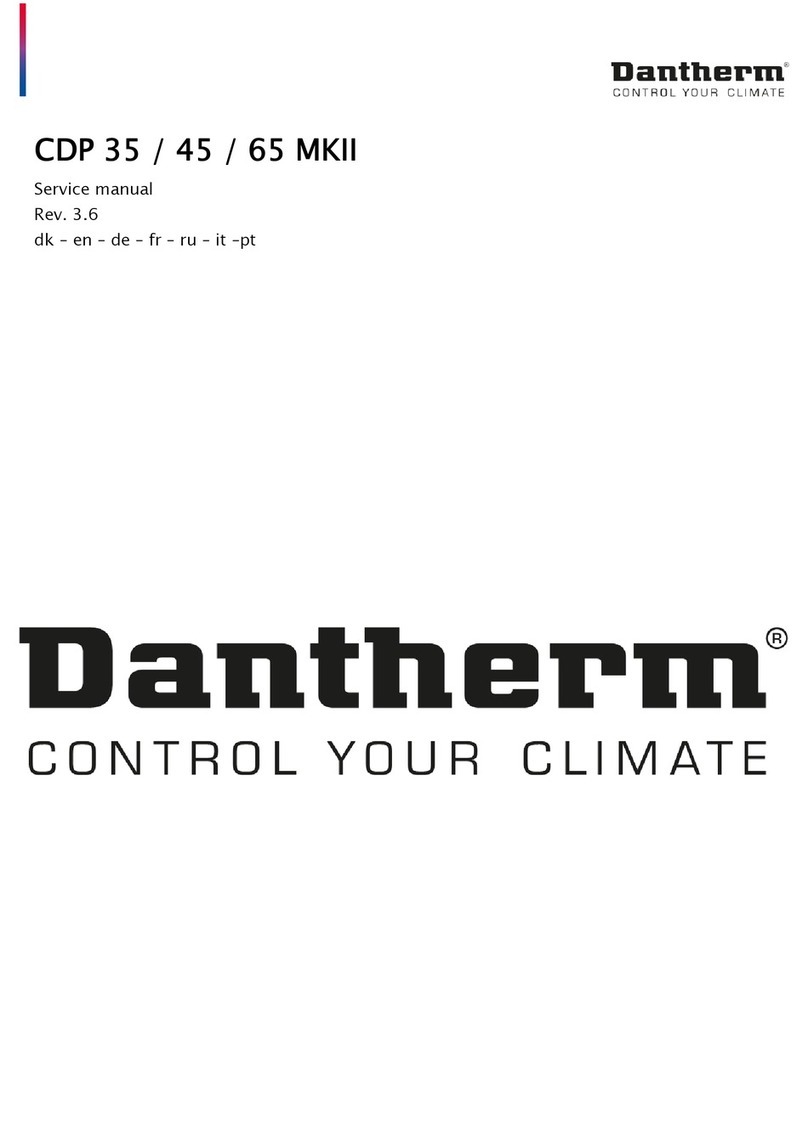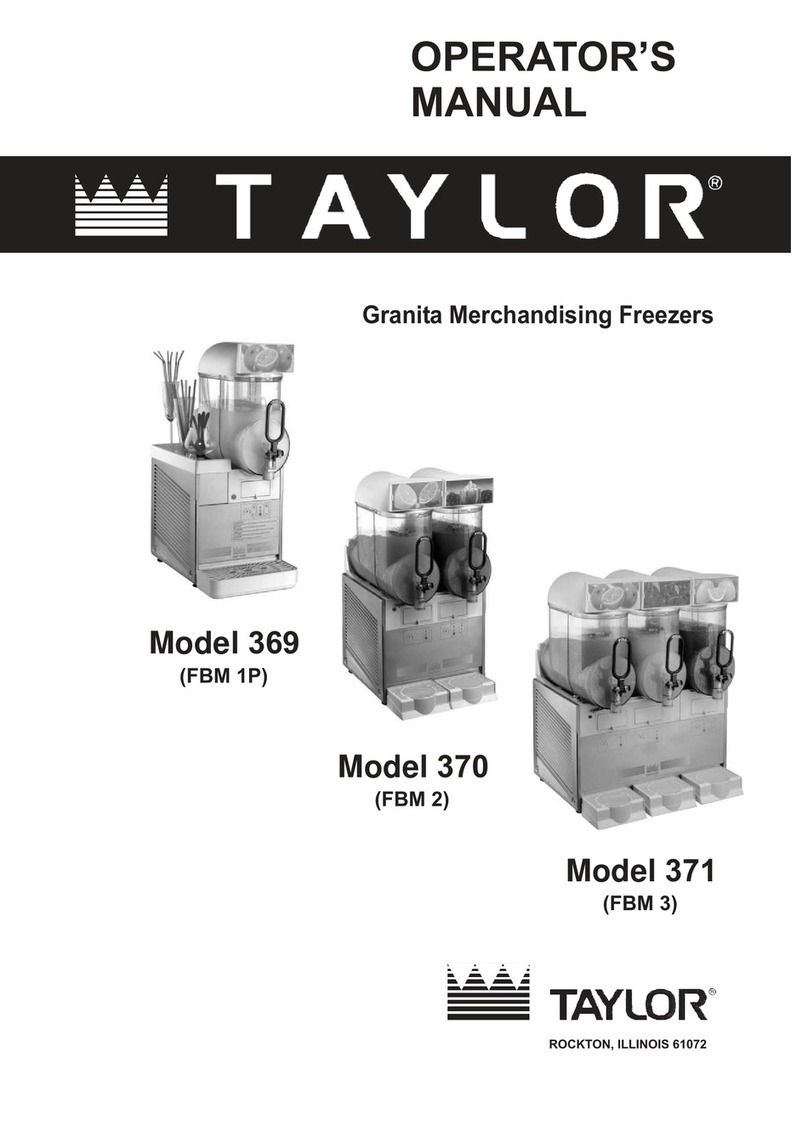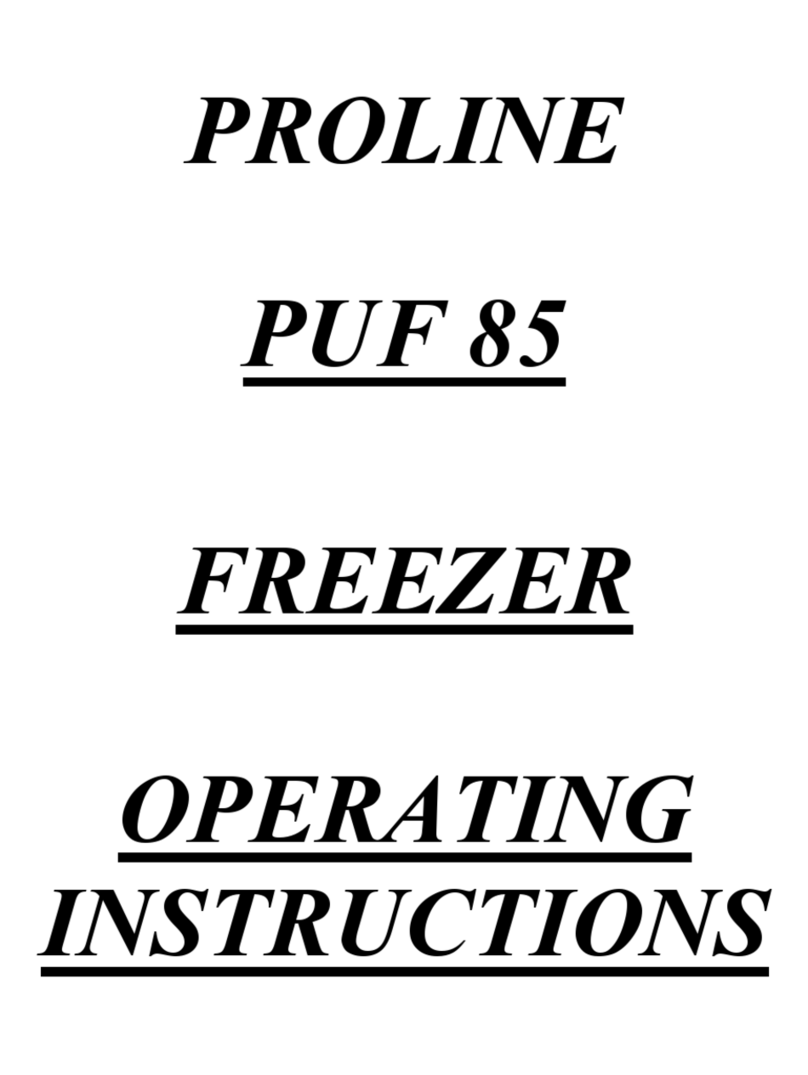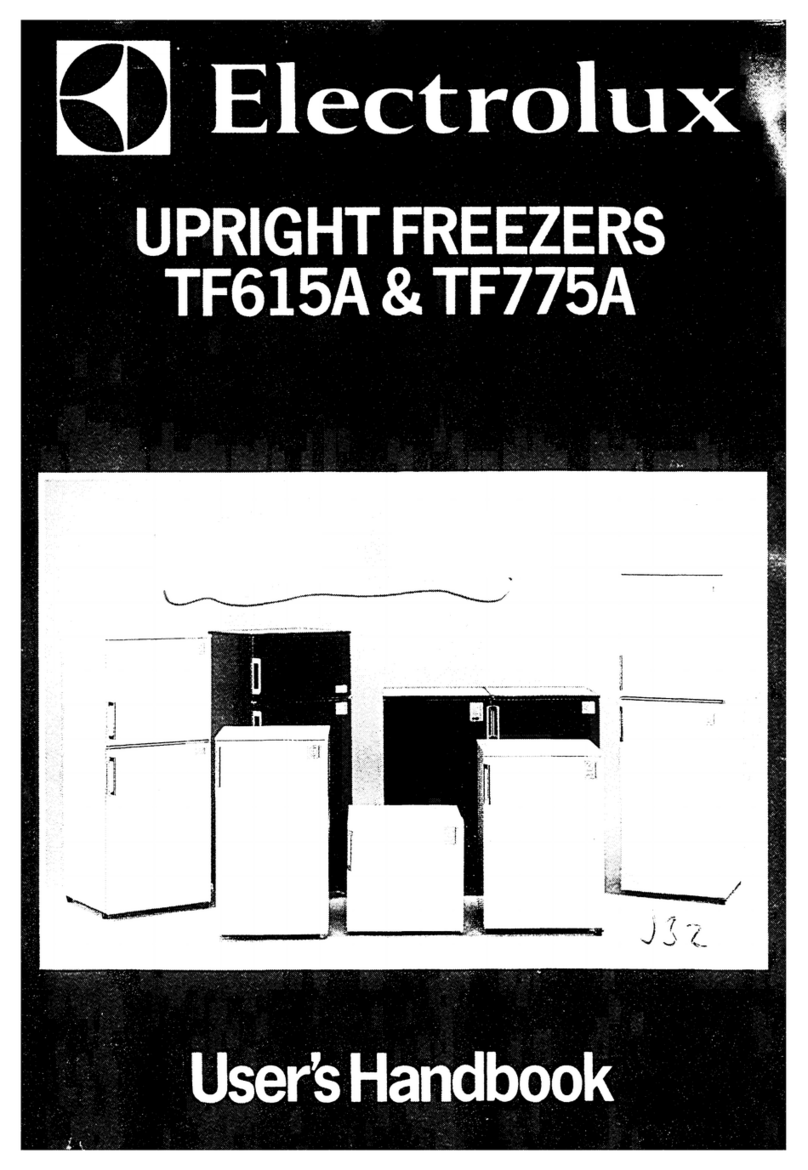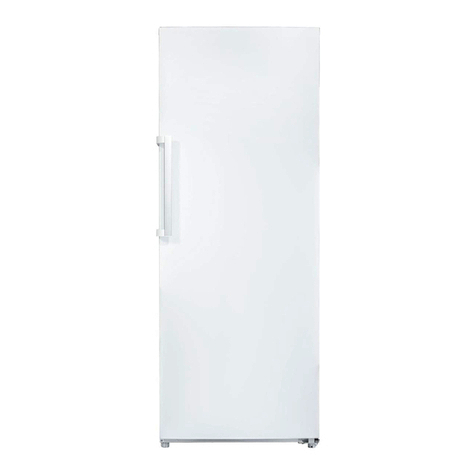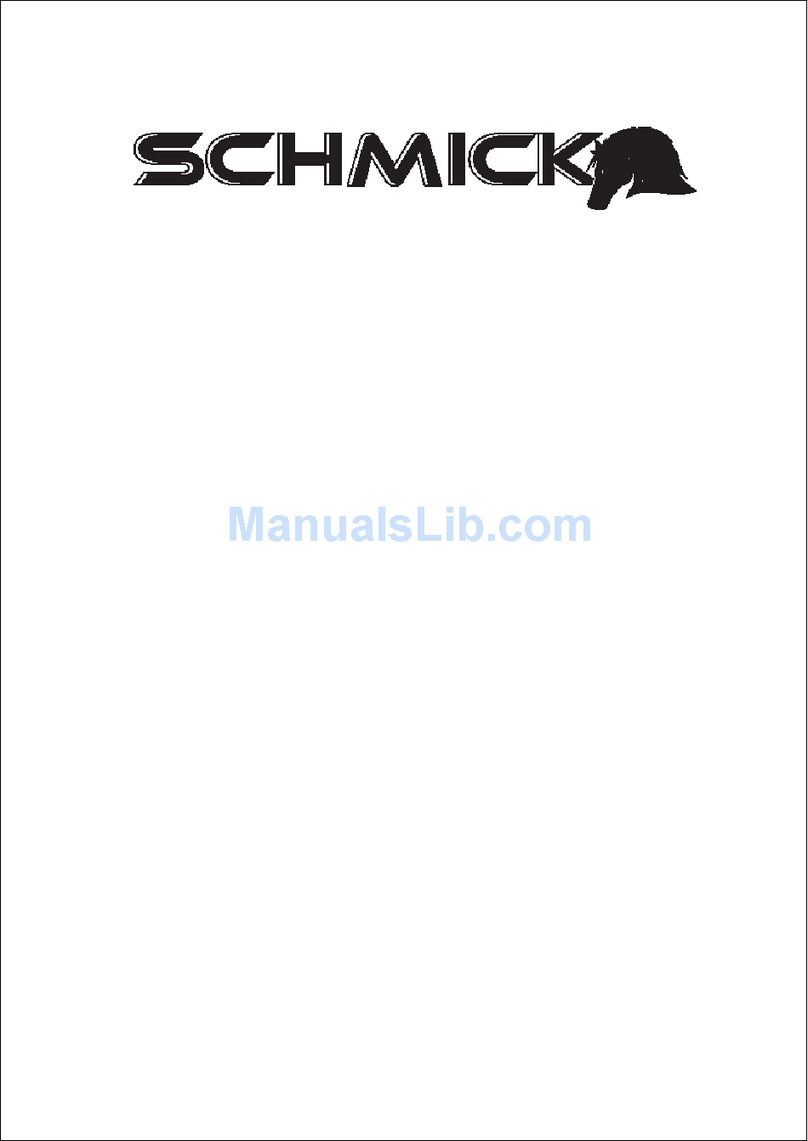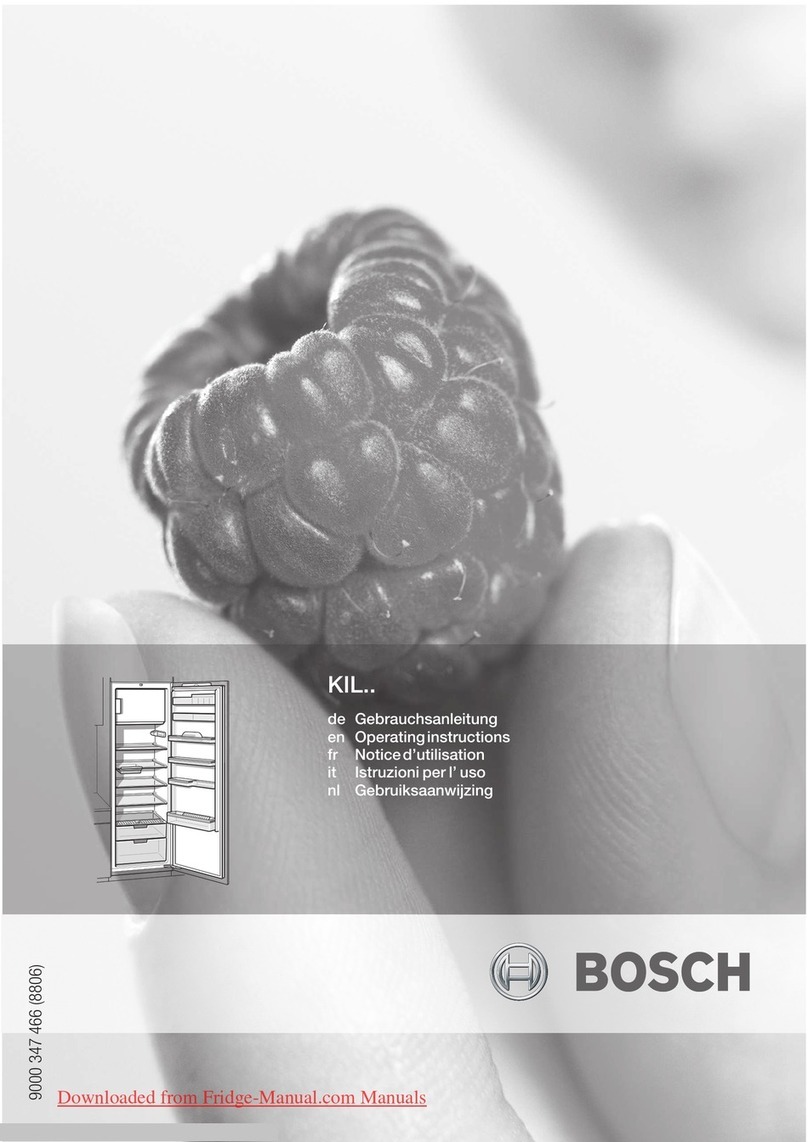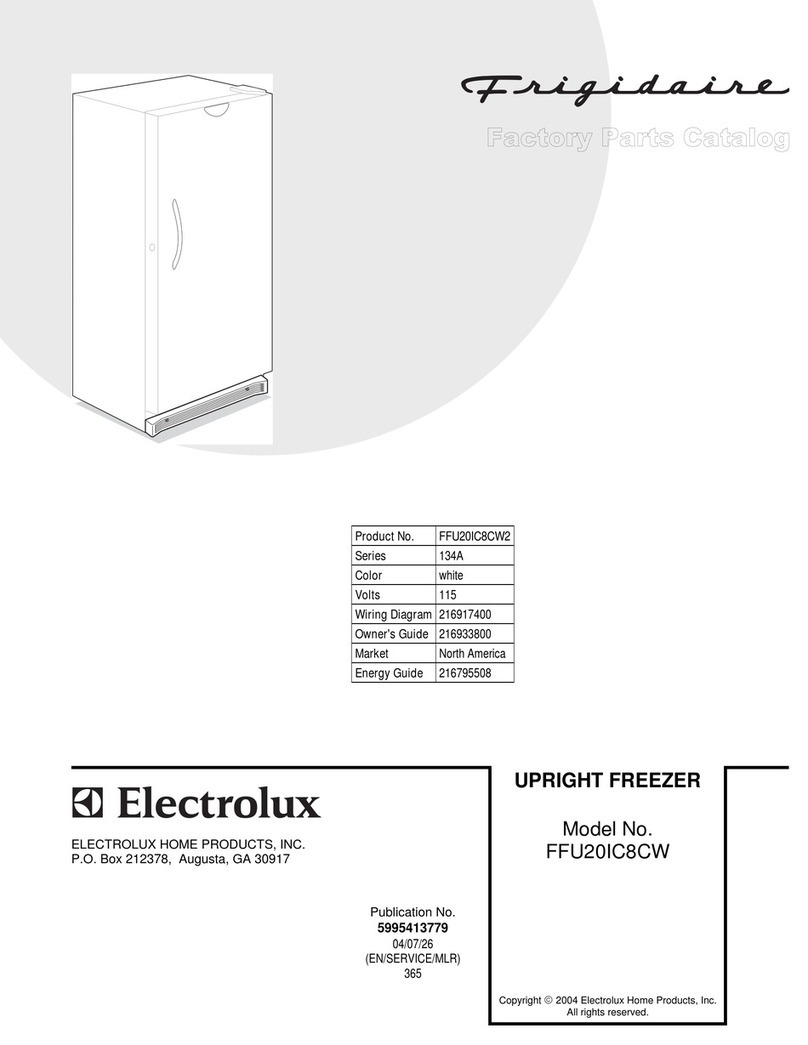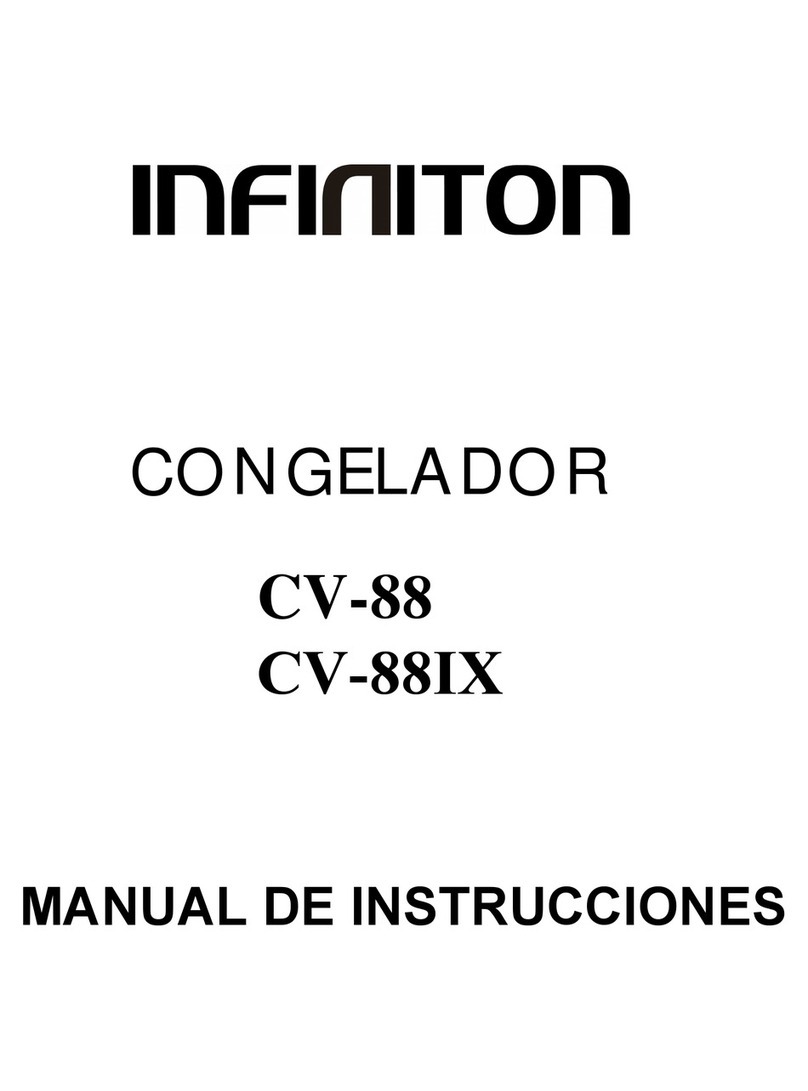CBS 2301 User manual

www.custombiogenics.com
74100 Van Dyke wBruce Twp., MI 48065 wUSA
1.800.523.0072 wTel: 1.586.331.2600 wFax: 1.586.331.2588
Leading the World with Innovative Cryopreservation Technology Solutions
EC REP
European Authorized Representative
EMERGO GROUP
Molenstraat 15
2513 BH, The Hague
The Netherlands
CUSTOM BIOGENIC SYSTEMS
2301 LN2 STORAGE UNIT
USER MANUAL

Custom Biogenic Systems liquid nitrogen freezers equipped with 2301 controllers are CE marked to the
Medical Device Directive. The Medical Device Directive is a European Union directive regulating medical device
construction and operation.
Custom BioGenic Systems
74100 Van Dyke Road
Bruce Township, MI 48065
European Authorized Representative
EMERGO GROUP
Molenstraat 15
2513 BH, The Hague
The Netherlands
Custom Biogenic Systems maintains ISO 13485:2003 Quality Management System
This manual covers the use of Custom Biogenic Systems Liquid Nitrogen Freezers equipped with 2301
controllers. This equipment is intended for use by trained personnel only. READ THE MANUAL BEFORE USING
THIS EQUIPMENT.
Custom Biogenic Systems Liquid Nitrogen Freezers covered in this manual are non-hazardous, open mouth
vacuum insulated dewars specically designed for use with liquid nitrogen. They are not subject to any
pressure vessel codes as they are open to atmospheric pressure. They are shipped empty without liquid
nitrogen or any hazardous material from our factory in Michigan
0086
Custom Biogenic Systems liquid nitrogen freezers, cryogenic equipment and accessories are designed
and intended for use with various applications where extremely low temperature storage is desired, such
as veterinarian, horticultural, pharmaceutical, industrial, scientic and research laboratories. They are not
intended for use in the diagnosis of disease or other conditions, or in the cure, mitigation, treatment or
prevention of disease, and as such have no medical purpose. They are designed for, but not limited to, use
in the laboratory environment.

www.custombiogenics.com
Thank you for choosing Custom BioGenic Systems
Custom BioGenic Systems can supply you with everything you need to eectively and safely store your samples.
Our 2101 controlled rate freezer will freeze your samples down at a controlled rate prior to long term liquid
nitrogen storage.
We have an extensive selection of freezer racks, bag storage solutions, boxes and dividers for liquid nitrogen
freezers, mechanical freezers as well as custom congurations.
For long term storage we oer our patented Isothermal dry storage liquid nitrogen freezers, carousel freezers,
standard liquid nitrogen freezers, cryosystems and dewars in many popular sizes.
VersAlert will monitor your temperature critical products and send alerts via text message or email if specied
parameters are exceeded.
For more information please contact Custom BioGenic Systems at 1.800.523.0072, www.custombiogenics.com

We at Custom BioGenic Systems are proud of our work, and appreciate your purchase
of this product. With proper care, this equipment will be trouble-free for many years to come.
Before setting up and using your new cryogenic storage unit, rst check to see that all parts
are accounted for and that no damage has occurred during shipping. Also, read this manual
completely before proceeding to set-up. If at any time you are unsure of the procedures for
set-up and use of this product, please contact CBS or your CBS sales representative.
NOTE: If equipment is used in a manner not specied by Custom BioGenic Systems,
the protection provided by the equipment will be impaired.
PRODUCT WARRANTY
Custom BioGenic Systems warrants all manufactured cryogenic equipment to
be free from defects in workmanship or materials for a period of ve year vacuum
warranty and a 2 year warranty on electronics and parts.
Custom BioGenic Systems’ liabilities under the warranty shall be limited to
correcting or replacing defective workmanship or materials. A claimant under the
warranty must notify Custom BioGenic Systems within (10) days after the discovery
of the defect. Custom BioGenic Systems reserves the right, at their discretion, to
correct the defect(s) in the eld without return shipment to the factory.
This warranty does not cover defects on cryogenic equipment resulting from
abusive handling and subsequent structural failure.
To register you Custom BioGenic Systems product(s) please go to
www.custombiogenics.com/registration.html
Controller Serial Number: Model:
Freezer Serial Number: Model:
For Technical Assistance Call: 1.800.523.0072 (U.S. Only)
Phone: 586.331.2600 Fax: 586.331.2588
www.custombiogenics.com
www.custombiogenics.com
IMPORTANT INFORMATION

www.custombiogenics.com
TABLE OF CONTENTS
Q&A Page 1
Safety 2-3
V Series and S Series Vessel Descriptions 4
Initial Set-Up 5
Operation 5
Front Panel Controls (ALL) 6
2301 Back Panel 7
Series 5000 Back Panel 8
V Series Manual Fill Instructions 9
Feature Details 10-11
Remote Alarm Wiring 12
Storage Unit Parameters 12
LCD Display Functions 13
Standard Operating Mode 14
Programming Mode 16
Verication & Calibration
High & Low Alarm Set Point Verication 26
Temperature Display Verication 26
2301 Temperature Calibration 27
V Series Level Display Verication & Calibration 28
Trouble Shooting 29-33
Plumbing Wiring Diagram Part ID 34
Plumbing Assembly Diagram 35
2301 Controller Wiring Diagram 36
2301 Controller Diagram Part ID 37
5000 2301 Controller Diagram Part ID 38
Series 2301 Controller Back Panel Part ID 39
Series 5000 2301 Controller Back Panel Part ID 40
90 Series Tank Diagram Part ID 41
S-1500 Series Tank Diagram Part ID 42
V-1500 Tank Diagram Part ID 43
3000 Tank Diagram Part ID 44
5000 & 5000EH Tank Diagram Part ID 45
Console and Rear Service Cover Assembly 46
Probe Assembly Diagram Part ID 47
Cleaning and Maintenance 48
EMC Test Report 49
Notes 50

www.custombiogenics.com
Recommended Best Practices in the industry for safe sample storage
Secondary or backup alarm
It is strongly recommended to have, at a minimum, an Independent Temperature Alarm
for each LN2 freezer.
Remote alarm connection
It is strongly recommended to have, at a minimum, a Remote Auto Dialer connected to
your Delta Room, Facility Monitoring Station or Remote Auto Dialer for each LN2 freezer.
Split Samples
Separate samples in to two dierent freezers.
Keep a daily log
Track temperature levels daily.
Record ll intervals and amount of LN2 lled into vessel (manual or pour-ll freezer or
dewar).
This information should be documented daily and reviewed monthly to foresee and
prevent future problems such as temperature uctuations and varying liquid levels.
Prepare a contact list
Have at least 3 people on your contact list with Home, Cell and Pager Number. Review the
list regularly for accuracy and changes.
Contingency plan
What to do if no one returns a call from your call list.
What to do if we run out of LN2 and it is a weekend or holiday.
What to do if you have a High Temp Alarm.
What to do if you have a Low Level Alarm.
What to do if you have a High Level Alarm.
What to do if you lose power.
What to do if you get a Source Alarm.
RECOMMENDED BEST PRACTICES

www.custombiogenics.com 1
QUESTIONS and ANSWERS
Keep your most important samples safe.
You can plan for the future, you can’t change the past.
Back-up or secondary Alarm
Q: Why do I need a Secondary or Back-Up Alarm?
A: Your freezer could malfunction. By having a secondary or back-up alarm you can minimize
the possibility of a loss due to a malfunction.
Remote Alarm Connection to your Delta Room, Facility Monitoring Station or Remote Auto
Dialer
Q: Why should I use my remote alarm feature or connection?
A: If an alarm occurs after hours, on a weekend or holiday the remote alarm connection will alert
you to a problem and let you address it quickly.
Q: I am not sure how to connect the alarm or what to connect the alarm to.
A: First, contact your lab manager, supervisor or in house biotech representative. If no one is
sure what to do, contact CBS customer service for help and direction.
Q: What is an Auto Dialer and why would I use one?
A: An Auto Dialer is used when a central connection is not available for the remote alarm. When
connected to a telephone land line the Auto Dialer will dial up to 8 dierent contacts.
If you have any question, comments or concerns please contact:
Custom BioGenic Systems Customer Service
Phone 586.331.2600
Toll free (US only) 800.523.0072

www.custombiogenics.com 2
WARNING
SAFETY
Go to custombiogenics.com/technicalguides.html
for more information.
IMPORTANT: The following section on SAFETY should be read carefully and followed completely. Warnings
regarding the handling of liquid nitrogen are by no means a complete volume on the safe use of cryogenic liq-
uids. All personnel should have complete knowledge of the correct procedures, as well as the hazards of work-
ing with liquid nitrogen. Failure to do so could result in serious injury or death. Be sure to read and understand
the Liquid Nitrogen Safety Data Sheet provided by your Liquid Nitrogen Supplier.
To avoid risk of electric shock, this equipment must only be connected to a supply mains with protective
earth.
The lid could present a crush hazard. Open the lid entirely and carefully to prevent the lid from
improperly engaging and falling. Use both hands while lowering lid into the closed position.
To prevent a rolling hazard, ensure the casters are locked.
HAZARDS ASSOCIATED WITH LIQUID NITROGEN:
Asphyxiation
When liquid is released into a conned space it displaces oxygen from the air. This results in an
oxygen-decient atmosphere, particularly if vented into a closed space, and asphyxia can result. Entering an
oxygen decient room can cause unconsciousness without warning. Always check air quality upon entering a
room where cryogenic liquids are being used, and if possible, have an air respirator available.
Cold Burns
Due to its extremely low temperature, the cold vapor and gas that are produced when liquid nitrogen boils
can give rise to cold burns or frostbite upon contact with unprotected skin. Exposure may also produce
discomfort in breathing and can provoke an asthma attack in susceptible individuals. Never allow direct skin
contact with liquid nitrogen or serious frostbite will result. Personal Protective Equipment (PPE) must be used,
based on the principle that it should prevent liquid nitrogen from touching the skin and eyes. Appropriate PPE
includes:
• Cryo-gloves (elbow length and loose tting).
• Safety goggles/full face shield.
• Long sleeve lab coat.
• Cryo-apron.
• Long pants that come over the top of shoes.
• Fully enclosed footwear.

www.custombiogenics.com 3
SAFETY
Boiling, Splashing and Spurting
Introducing equipment which is at room temperature into liquid nitrogen is always somewhat hazardous.
Beware of splashing and “boiling”which may occur. Never dip a hollow tube into liquid nitrogen; it may
spurt liquid nitrogen.
Compatibility
Liquid nitrogen should ony be handled and transported in approved containers. Liquid nitrogen may alter
the physical characteristics of many materials, make them brittle and fail. Liquid nitrogen should never be
used in combination with other substances or materials without knowing what the result will be. When in
doubt, contact a competent authority.
Fire in Oxygen-Enriched Atmostphere
Liquid Nitrogen can condense oxygen from the atmosphere. Liquid oxygen creates potential-
ly ammable or explosive conditions by greatly increasing the combustibility of many materials
(e.g. solvents, hydrocarbons).
FIRST AID
In the event a person has frostbite from liquid nitrogen, the following rst aid treatment should be given
while awaiting the arrival of medics or a doctor.
1. If the material has contaced skin or eyes, ood those areas with large quantities of unheated water
and protect frozen areas with loose, bulky, dry, and sterile dressings.
2. If the skin is blistered or there is a chance that the eyes have been aected, seek medical help
immediatley.
SPECIFIC FIRST AID PROCEDURES: PROMPT MEDICAL ATTENTION IS MANDATORY IN ALL CASES OF
OVEREXPOSURE TO NITROGEN. RESCUE PERSONNEL SHOULD BE EQUIPPED WITH SELFCONTAINED
BREATHING APPARATUS.
INHALATION: Conscious persons should be assisted to an uncontaminated area and inhale fresh air. Quick
removal from the contaminated area is most important. Unconscious persons should be moved to an
uncontaminated area, given mouth-to-mouth resuscitation and supplemental oxygen. Further treatment
should be symptomatic and supportive.
SKIN OR EYE CONTACT: Flush aected areas with lukewarm water. DO NOT USE HOT WATER. A physician
should see the patient promtly, especially if the cryogenic “burn” has resulted in blistering

Throughout this manual references are made to the “S Series”
and “V Series” storage unit vessels. In order to give a complete
understanding of the dierence between these two models,
the diagrams at right are being provided. They show clearly the
dierence between the two, and the characteristics of each.
Although the two are quite dierent physically, they operate in
essentially the same way, and the electronic controls are identical for
them both. Whenever there is a dierent procedure or operation for
one, we’ve clearly stated the dierent instructions for each model.
When not stated as dierent, the procedure or operation is the same
for both.
What makes these two designs so dierent is this basic fact:
With the S Series models, the liquid nitrogen is contained
within the storage vessel, and the stored samples are, or are
potentially, in contact with the liquid.
With the V Series or Isothermal models, the liquid nitrogen
is contained inside the vessel walls, and the stored samples never
come into contact with the liquid nitrogen except in the case of an
accidental overll.
To understand the way the system operates, see the
OPERATION section on the next page for a basic explanation of
the mechanics of the system. Also, be sure to read this manual
completely before attempting to use this equipment. If you are still
not sure how to use this equipment properly, contact a competent
authority, rather than risking your safety or the safety of the stored
samples.
When the unit is placed into service, check daily to ensure
proper operation and safety of the stored samples. For the V Series
units, it is essential to lift the lid each day and check for vapor and
signs of proper freezing.
V SERIES (ISOTHERMAL) VESSEL
LIQUID NITROGEN IS CONTAINED INSIDE
THE VESSEL WALLS, AND DOES NOT
CONTACT THE INVENTORY SYSTEM.
S SERIES (STANDARD) VESSEL
LIQUID NITROGEN IS CONTAINED WITHIN
THE VESSEL, AND IS DIRECT CONTACT WITH
THE INVENTORY SYSTEM.
V SERIES AND S SERIES DESCRIPTIONS
Go to custombiogenics.com/technicalguides.html
for more information.
www.custombiogenics.com 4

www.custombiogenics.com 5
This equipment is designed to operate in the following environmental conditions:
Temperature: 5°C (41°F) to 40°C (104°F)
Humidity: 80% at ≤ 31°C, decreasing linearly to 50% at 40°C
Altitude: ≤ 2,000 meters (6,650 feet)
As a rst step in the set-up procedure, be sure to read this manual completely to become more familiar
with this equipment. Next, remove all packing materials and wipe unit with a clean cloth inside and out to
remove any debris left from shipping. Once the unit is wiped down, complete the following Steps: (Note: The
Temp A/Temp B alarm is set at +30°C from the factory. Thus, it will not alarm during the rst ll and must
be set by the user once the freezer cools.(-150°C)
1. (Connect the LN2stainless steel exible hose from the supply tank to the storage freezer), but do not open
the manual supply valve until instructed to do so.
2. Connect Remote Alarm or Auto Dialer if desired.
3. Plug unit into an appropriate power source.
4. Turn the power key switch to the “ON”position and the program/lock to program.
5. Adjust the Liquid Level Set points. See display #4 on page 16 for instructions.(press LIQ’D level)
6. Adjust the High Temperature Alarm Set point after lling is complete. See display #5 on page 16 for
instructions. (press “TEMP”)
7. Open the manual valve on the supply tank. Check for leaks at the connection points, then proceed to
normal operation.
The S Series Storage Units are designed to maintain liquid nitrogen levels within specied parameters inside
a cryogenic storage vessel. The V Series Storage Units are designed to maintain liquid nitrogen levels within
specied parameters inside the walls of a cryogenic storage vessel. This is achieved by measuring gravitational
weight of the liquid nitrogen with a pressure sensing unit in the controller. The controller activates the FILL
solenoid valve when the liquid level goes below the LOW level set point, and deactivates the solenoid valve,
stopping the ll, when the level reaches the HIGH set point.
The Bypass Function has an additional solenoid valve to vent vapor from the transfer lines before the
FILL solenoid is activated. In the description below, the part of the sequence which is unique to the Bypass
Function is in [brackets]. All other information refers to units with or without the Bypass Function.
During regular operation, the sequence of events is as follows: When the liquid level in the vessel falls
below the low level set point, a signal is sent to the controller. At this time the FILL solenoid valve is activated,
allowing the ow of liquid into the vessel. [The Bypass Function will activate the VENT solenoid rst to release gas
or vapor from the transfer lines. The venting will continue until the line temperature reaches approximately -150° to
-160°C. This can be adjusted, consult the factory for more information. When the line reaches this temperature the
vessel will begin to ll.] When the liquid level reaches the high level set point a signal is sent to the controller
which deactivates the solenoid valve and stops the ow of liquid into the vessel. As long as the unit is powered
up, this ll sequence repeats as necessary, maintaining the desired liquid level.
Check unit daily to ensure proper operation and safety of the stored samples. For the V Series units, it is
essential to lift the lid each day and check for vapor and signs of proper freezing.
Whenever working with Liquid Nitrogen in an enclosed space,
the use of personal O2detection equipment is recommended.
Storage units should not be disconnected
from their supply while attempting to ll.
INITIAL SET-UP
OPERATION
Lid must be open for rst ll cycle
Go to custombiogenics.com/technicalguides.html
for more information.

1. Key - Switch Power Control - Main power control for the unit.
2. LCD Display Window - Text interface for the storage unit electronic settings. See page 13
for complete listing of all display menus and functions.
3. First Menu Select Button - This is used to select various control menus and to make
changes in programming as shown by the text which appears above the button.
4. Second Menu Select Button - This is used to select various control menus and to make
changes in programming as shown by the text which appears above the button.
5. Third Menu Select Button - This is used to select various control menus and to make
changes in programming as shown by the text which appears above the button.
6. Fourth Menu Select Button - This is used to select various control menus and to make
changes in programming as shown by the text which appears above the button.
7. Scroll “Down” Button - Scrolls to lower numbers when programming electronics.
8. Scroll “Up” Button - Scrolls to higher numbers when programming electronics.
9. “Program / Lock” Key Switch - Switches the controller between the Standard Operat-
ing Mode and the Program Mode. Also protects electronic programming from being
changed by unauthorized personnel.
12 8 9
7
6
5
4
3
www.custombiogenics.com 6
Warning: Depressing buttons with pointed objects
(Pen, Pencil, etc.) will damage buttons
FRONT PANEL CONTROLS

www.custombiogenics.com 7
1. Vent Thermocouple- The Vent Thermocouple Plugs in here.
2. Lid Temp. A Thermocouple- The Lid Temp A Thermocouple Plugs in here. (see page 11)
3. Lid Temp B Thermocouple- The Lid Temp B Thermocouple Plugs in here. (see page 11)
4. Ethernet Port- The Ethernet Cord for future expansion.
5. RS-485 IN- Used for RS-485 Cryomonitor communication between controllers.
6. RS-485 OUT - Used for RS-485 Cryomonitor communication between controllers.
7. Lid Switch - Used to indicate “Lid Open” condition.
8. Sensor Port - Used to sense level in vessel.
9. Fill/Vent In Progress - Outputs 24V DC whenever lling or venting. (see page 11)
10. Fill Solenoid Valve Outlet - The ll solenoid valve plugs in here. (Specications: Rating:
100VAC 2A, Insulation Resistance: 300Ω minimum @500VDC, Dielectric Strength:
1,000VAC for 1 minute, Contact Resistance: 20mΩ maximum, Withstand Voltage:
1,000VAC for 1 minute, Insertion Force: 4Kg max, Withdrawal Force: 1-3.5Kg).
11. Vent Solenoid Valve Outlet - The vent solenoid valve plugs in here. (see specications
in #10)
12. Global Remote Alarm - Dry contact that switches status when any alarm occurs. (see
page 12) All Global Alarm connections are contact relays with max output of 24VDC@2A
13. 2 Amp Fuse - VAC 2 amp buss fuse; 220 volts slow-blow. (T2A-250V)
14. 24 V Power Supply - This is the main power supply cord to the unit, be sure to check for
proper voltage - See voltage requirements on the controller.
15. Overow Sensor (Optional)- If installed, used to sense an overow condition in the
storage space of a vessel. (see page 11)
16. Thermal Printer Port - Used for printing alarms & data.
17. 16 Port Connector - Operational range: Temperature is +50° C to -200°C Level: 0”-33”
• 0-5VDC Outputs - For Temp. A, Temp B. and Level. (see page 11)
• 4-20mA Outputs - For Temp A. , Temp B. and Level. (see page 11)
• SEQ/OFAF Input and Output Connection - For communication between controllers. (see page 10)
18. AUX RS 485 - RS-485 communications port for future expansion.
19. USB Port - Used for Cryomonitor communications with PC.
123456789 10 11 12 13
1718 16 15 14
SERIES 2301 CONTROLLER BACK PANEL
19

www.custombiogenics.com 8
SERIES 5000 BACK PANEL
1. 2 Amp Fuse - VAC 2 amp buss fuse; 220 volts slow-blow. (T2A-250V)
2. Global Remote Alarm - Dry contact that switches status when any alarm occurs. All Global
Alarm connections are dry contact relays with a max output of 24VDC@2A(see page 12)
3. Thermal Printer Port - Used for printing alarms & data.
4. AUX RS 485 - RS-485 communications port for future expansion.
5. Ethernet Port- The Ethernet Cord for future expansion.
6. RS-485 IN- Used for RS-485 Cryomonitor communication between controllers.
7. RS-485 OUT - Used for RS-485 Cryomonitor communication between controllers.
8. USB Port - Used for Cryomonitor communications with PC.
9. Overow Sensor (Optional)- If installed, used to sense an overow condition in the storage
space of a vessel. (see page 11)
10. 16 Port Connector - Operational range: Temperature is +50° C to -200°C Level: 0”-33”
• 0-5VDC Outputs - For Temp. A, Temp B. and Level. (see page 11)
• 4-20mA Outputs - For Temp A. , Temp B. and Level. (see page 11)
1234567
89 10

www.custombiogenics.com 9
The unique design of the new Isothermal Storage Unit is such that it is no longer
necessary to ll the storage chamber with liquid nitrogen. Instead, the inner walls of the storage
vessel are lled with liquid nitrogen and the storage chamber holds no liquid at all. Because of
this unique design, the manual lling of this equipment is very dierent from storage units of
the past. Use the following instructions to manually ll the Isothermal Storage unit in the event
of a power outage or if the auto-ll is not working properly.
For the correct manual lling of the Isothermal unit perform the following steps:
1. Turn o the liquid nitrogen supply valve at the supply tank.
2. Disconnect the supply line from the Isothermal Unit at the port on the back of the unit.
3. Remove the cap from the manual ll port, also on the back of the unit.
4. Place the cap on the auto-ll port where the supply line was connected, and tighten down.
5. Connect the liquid nitrogen supply line to the manual ll port, and tighten down.
IMPORTANT: It is not recommended to attempt to manually ll the Isothermal Storage
Unit by opening the lid and placing a ll line over the edge into the vessel. This is an incorrect
ll method and will cause liquid nitrogen to come in contact with the stored samples.
CAUTION: Before opening the supply valve to ll the Isothermal Unit, read the
following text to learn how to gauge the liquid level, so the Storage Unit does not
overll and create hazardous conditions.
V SERIES MANUAL FILL INSTRUCTIONS
AUTO-FILL
CONNECTION
MANUAL-FILL
CONNECTION
Without power there will be no digital display to give the liquid level, and the liquid
cannot be seen visually since it is contained inside the walls of the Isothermal Unit. Thus the lid
must remain open during the manual ll process. With this in mind, the best way to gauge the
ll level is when the tank is nearing maximum ll, liquid nitrogen will begin to “spray” from the
vents located near the top edge of the inner walls of the vessel. When this is seen, the supply
valve should be shut o immediately before excessive amounts of liquid nitrogen begin to spill
into the storage space.

www.custombiogenics.com 10
TANK 1 TANK 2 TANK 3 TANK 4
SEQUENTIAL FILL
HL
LL
HL
LL
HL
LL
HL
LL
HL
LL
1
2
3
4
5
HL
LL
1
HL
LL
3
HL
LL
2
TANK 1 TANK 2 TANK 3 TANK 4
SIMULTANEOUS FILL
SEQ/OFAF system: (See page 16 screen # 7)
SEQUENTIAL MODE (recommended):
• Connectall2301controllerstoyourLN2supplysource.
• Select“Sequential”modetomaintainoptimumllpressureandsignicantlyreduceLN2transferloss.
• OncetherstcontrollerreachesitsHighLevelSetPoint,itwillactivatethenextcontroller.Thisprocess
will continue until all linked controllers have reached their High Level Set Point sequentially.
SIMULTANEOUS MODE:
• Connectall2301controllerstoyourLN2supplysource.
• Select“Simultaneous”mode.
• AllfreezerswillbegintollatthesametimeuntilalllinkedcontrollershavereachedtheirHighLevelSet
Point simultaneously.
Connection:
Connect all 2301 controllers you want linked using a two conductor wire going from one 2301 control-
lers SEQ/OFAF output to the next 2301 SEQ/OFAF input. Continue making these connections until all the desired
2301 controllers are connected in a complete loop. To set the system each controller must be powered o and
back on to reset.
Custom BioGenic Systems recommends selecting “Sequential”. This mode allows freezers to ll one at
a time with a primed and cold supply system making it easier to maintain proper lling pressure and reducing
LN2 transfer loss. This is more ecient than a keep cold system.
For best results with large pipeline LN2 supply systems, adjustment to the source alarm timer may be
required. Please contact Custom BioGenic Systems with any questions regarding the function and setup of the
SEQ/OFAF feature. In the event of an alarm status that stops the freezer from reaching the High Level Set Point,
the 2301 controller will not trigger the next freezer in line to ll. However the auto ll function always takes
priority over the SEQ/OFAF settings. The next freezer to ll will trigger the SEQ/OFAF system. Custom BioGenic
Systems has programmable timers factory set to stop the system from going into a continuous loop. Given this
feature is connected using a simple two conductor wire relay closures, an innite number of 2301 controllers
can be connected to this system.
FEATURE DETAILS
Go to custombiogenics.com/technicalguides.html
for more information.

www.custombiogenics.com 11
FEATURE DETAILS
Fill Timer: (See page 16 screen #6)
Enables setting the timer to ll the freezer at 24, 48 or 72 hour intervals at the time selected. Note that the Auto
Fill setting will always override the Fill Timer setting.
Lid Temperature Display:
• LidTemperatureAThermocoupleislocatedapproximately11”fromthetopofthetank.
• LidTemperatureBThermocoupleislocatedapproximately20”fromthetopofthetank.
0-5Vdc & 4-20mA Outputs:
Easy screw terminal output connections for existing alarm and monitoring systems. This feature is available
through the Tank ID menu (See page 16 screen # 4). Select either:
• 0-5VdcwithconnectionstoTemp-A,Temp-BandLevel
• 4-20mAwithconnectionstoTemp-A,Temp-BandLevel
Operational range: Temperature is +50° C to -200°C Level: 0”-33”
Fill/Vent In Progress:
Can be used as a signal to activate the Custom BioGenic Systems TS-1B LN2 supply tank switcher or an additional
24Vdc valve to control the LN2 supply.
• Outputs 24VDC whenever lling or venting.
Report Log Feature: (See page 15 screen #99)
• Alarms–RecordsSequenceofeventssuchasPOWERON,LIDOPEN,etc…
• Data–TheLOGfunctionisenabledforusewitheitherCryomonitororReporting.ThiswillDate/Timestamp
Temp-A, Temp-B and Level at the programmable rate of 1-90 hours on the hour. This information is selected by
date range to either be displayed or printed for easy review.
Optional Features
Overow Sensor: (Not included as standard equipment, can be purchased separately)
This feature uses a thermistor set at the bottom of the storage space along the probe holder tube. If an overow
occurs it will cause the LN2 to make contact with the thermistor. An audible and visual alarm will occur and
“SYSTEM STATUS: ALARM ** LN2 OVERFLOW **” will appear on the display and power to all solenoid valves will be
disabled.
NOTE: Turbulence from liquid nitrogen supply may trip alarm if operated at higher levels than factory set points
(Low: 10” High: 17”).
Go to custombiogenics.com/technicalguides.html
for more information.

www.custombiogenics.com 12
Locate the Remote Alarm Connector on the controller (#12 on page 7; #2 on page 8). This
is where the remote alarm or auto dialer will plug into the control unit. All Global Alarm
connections are dry contact relays with a max output of 24VDC@2A.
The Remote Alarm Connector is a Dry
Contact.
The Diagram shows connections for
wiring arrangement.
First, wires from the remote alarm or auto dialer must be connected to the plug-end which plugs into
the Remote Alarm Connector. Use the diagram to connect wires from the remote unit.
When unit goes into an alarm condition or loses power, the contacts will switch their “Open” or “Closed”
state to be the opposite of when there was not an alarm condition, thereby sending a signal to the
remote alarm or auto dialer. Wiring it to common and normally open will trigger the remote contact if a
power failure occurs
Cooling medium: Liquid nitrogen only (supplied by a pressurized cryogenic transport vessel)
Operating Pressure: 22 p.s.i.
This Unit has been tested and complies with the EN60601-1 Standards.
Power Supply Voltage: 120 Volts AC 60 Hz standard - 220 Volts AC 60/50 Hz optional
Amperage: 2 amp max
Fuse: VAC 2 amp Buss fuse; 220 volts slow-blow. (T2A 250V) (automotive glass tube type fuse)
Operating levels for LN2: Extra High Series: 1 to 31 inches (higher ll heights may be used, call CBS for more info)
V Series Models: 1 to 23 inches
IMPORTANT: Normal operating pressure is 25 p.s.i. max/ 20 p.s.i. min (22 p.s.i. recommended) if
the pressure is greater or less than, the eciency of your liquid nitrogen storage unit could be
aected. This could be noticeable in ways such as increased liquid use, level and source alarms.
REMOTE ALARM WIRING
STORAGE UNIT PARAMETERS
Specication: V1500AB V3000AB V5000AB V5000ABEH
LN2 Capacity (Liters) 30 70 93 140
Static Evaporation Rate (Liters/Day) 5 9 11 11
Static Holding Time (Days) 6 8 8 12
External Dimensions
Width (in/mm) 26 / 660 37 / 939 47 / 1219 47 / 1219
Depth (in/mm) 37 / 939 48 / 1219 54 / 1371 54 / 1371
Height (in/mm) 45 / 1143 47.5 / 1206 52 / 1320 58 / 1473
Usable Interior Height (in/mm) 29 / 736 29 / 736 29 / 736 34 / 864
Usable Interior Diameter( in/mm) 21 / 534 31 / 787 40 / 1016 40 / 1016
Weight Empty (lbs/kg) 327/148 600/272 936/425 997/453
Weight Full (lbs/kg) 383/174 720/327 1100/500 1247/566
Remote Alarm
connector jack
on unit back panel
Push into place
(only goes one way) Remote Alarm connector
(be sure to push inside
pin after wiring)
Common
Normally
Open
Normally
Closed

www.custombiogenics.com 13
This section shows each display window and gives important information necessary for understanding and
operating the LCD text functions of the 2301 Controller.
To start, the index below shows where in this section to nd each and every function of the controller.
This will enable the user to correctly program all functions of the storage unit to meet their individual needs.
The overall operation consists of two basic modes: the Standard Operating Mode, and the Program
Mode. The unit is in the Standard Operating Mode when the Program/Lock key switch on the front panel (Page
6, number 9) is turned to Lock. To enter the Program Mode, the key must be inserted and the switch turned to
Program.
In the Standard Operating Mode, there are 6 dierent displays possible. They are as follows:
Standard Display - Display number 1 - page 14
Standard Display While Unit is Filling - Display number 2 - page 14
Standard Display With Lid Open - Display number 3 - page 15
Alarm Condition Display - Display number 90 - page 15
Alarm Condition Display With Audible Alarm Muted - Display number 91 - page 15
Printing Report - Display number 99 - page 15
The Alarm Condition display will give the specic cause of each alarm condition that may be occurring.
The following is a list of the possible alarm conditions:
Low Alarm Open Fill
High Alarm Open Bypass
Source Alarm Temp. A Probe
Temp. A High Temp. B Probe
Temp. B High Open BP Probe
Thermistor Open LN2 Overow “Optional” Additional Equipment Required
In the Program Mode, there are various displays possible. The following is a list of programming
functions and the corresponding display windows. For each of these programming functions, there may be sub-
menus that follow the primary display window. The sub-menus are not listed here, but are shown and explained
following the primary windows. The primary programming functions are as follows:
Main Menu - Display number 4 - page 16 Provides access to:
Date/Time Settings - Display number 8 - page 17
Tank ID Settings - Display number 13 - page 18
Liquid Level Settings - Display number 15 - page 18
Main Menu 2 - Display number 5 - page 16 Provides access to:
Temp Settings - Display number 19 - page 18
Printer Functions - Display number 22 - page 19
Bypass Settings - Display number 24 - page 19
Main Menu 3 - Display number 6 - page 16 Provides access to:
Control Validation - Display number 40 - page 20
Fill Timer Settings - Display number 7A - page 17
Revision level- Display number 42 - page 23
Main Menu 4 - Display number 7 - Page 16 Provides access to:
One Fill All Fill - Display #44 on page 24
Log - Display #45 on Page 23
Return to Main Menu - Display #4 on page 16
LCD DISPLAY FUNCTIONS

www.custombiogenics.com 14
Using The Diagrams to Understand the Display Functions
WARNING: NEVER USE AN OBJECT OTHER THAN YOUR FINGER TO PRESS THESE BUTTONS. DOING SO WILL RESULT IN
PERMANENT DAMAGE TO THE CONTROLLER OVERLAY.
Below is a sample display window as they’re shown in the following section. Use the diagram to become familiar
with the way this section is organized, and how the information is presented in reference to each display
window and it’s functions. (NOTE: Tolerance on Liquid Level Display is +/- 1” (2.54cm) and the tolerance on the
temperature display is +/- 1°C)
SAMPLE DISPLAY WINDOW
X’s ARE USED IN PLACE OF NUMBERS IN THE DISPLAY WINDOW, SINCE THE ACTUAL NUMBERS WILL VARY.
THIS NUMBER TO THE LEFT OF
EACH WINDOW IS A GENERAL
IDENTIFICATION NUMBER
USED TO ORGANIZE THE
DISPLAYS FOR THIS MANUAL.
THIS NUMBER WILL NOT
APPEAR ANYWHERE ON THE
CONTROLLER OR THE ACTUAL
DISPLAY WINDOWS
THE TEXT TO
THE RIGHT OF THE DISPLAY
EXPLAINS THE SPECIFICS
OF THE DISPLAY MESSAGE AND
WHY IT IS OCCURRING
This is the standard display
which will appear during normal
operation under most circumstances.
Press this button to
advance to display #99
(see page 15) and print
report (see page 19)
Press this button to
begin a manual ll
#1
THE TEXT BELOW THE BUTTONS EXPLAINS
THE FUNCTION OF EACH OF THE BUTTONS.
ALSO TELLS WHICH DISPLAY THE BUTTON WILL
ADVANCE TO, AND THE PAGE NUMBER WHERE IT
CAN BE FOUND IN THE INSTRUCTION MANUAL
This is the standard display
which will appear during
normal operation under most
circumstances.
NOTE: Use Up/Down arrows to toggle
display between Temp. A and Temp. B
#1
#2
This display will appear during normal
operation when either a manual or
automatic ll is occurring.
LCD DISPLAY FUNCTIONS
Standard Operating Mode Display Windows
This manual suits for next models
4
Table of contents
Popular Freezer manuals by other brands

Grundig
Grundig GKN4582VW user manual
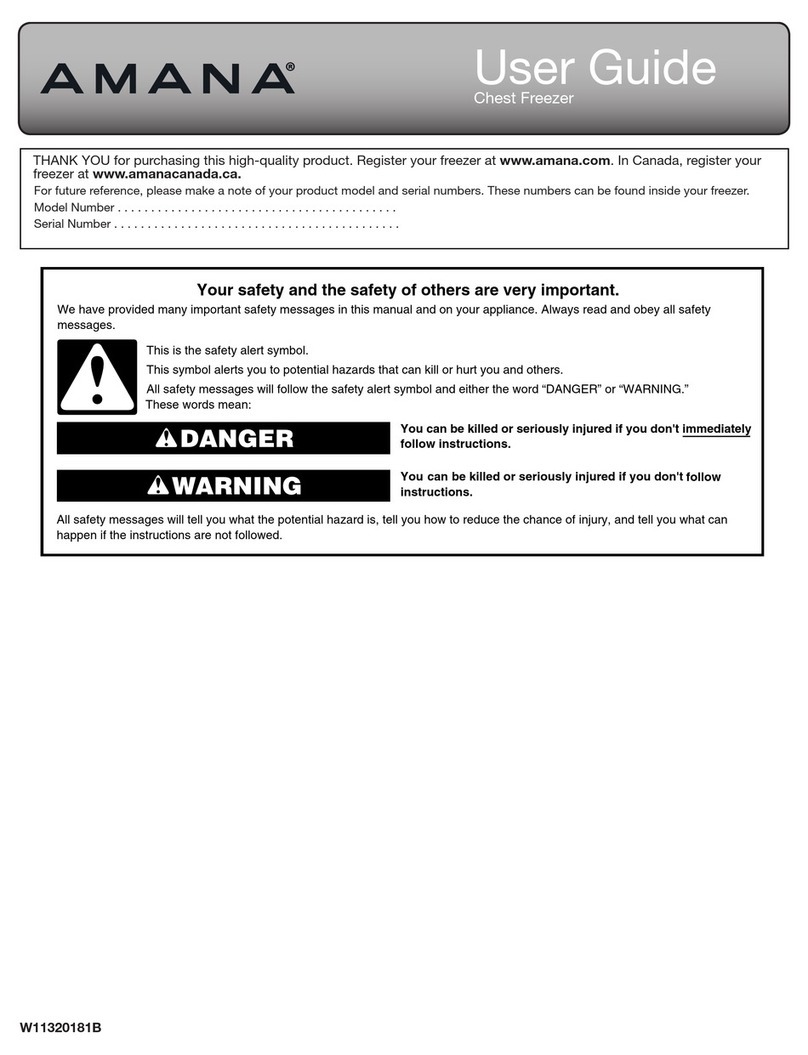
Amana
Amana AZC31T15D user guide
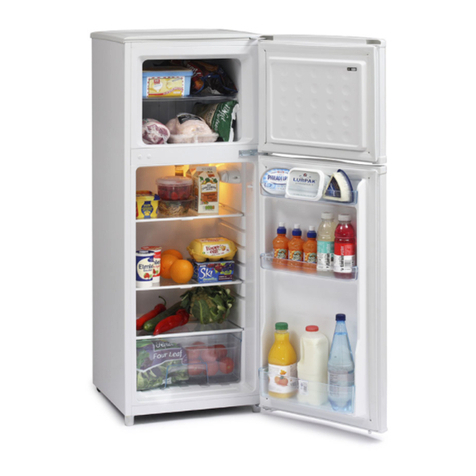
Iceking
Iceking FF139W Installation and operating manual

AEG
AEG SANTO C 8 18 43 i Operating and installation instructions
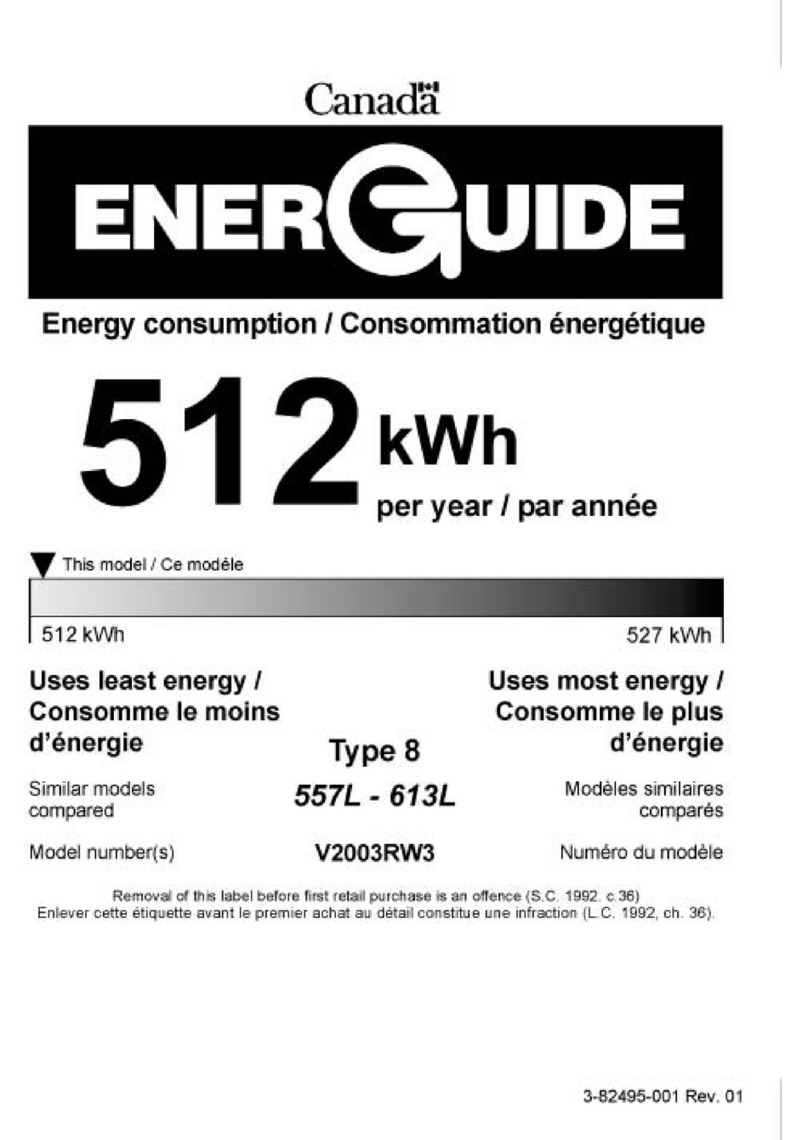
WC Wood
WC Wood V2003RW3 Energy guide
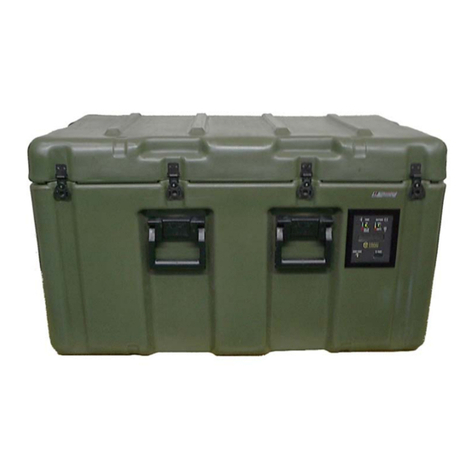
Energy Storage Technologies
Energy Storage Technologies HemaCool HMC-MIL-1 operation & maintenance
